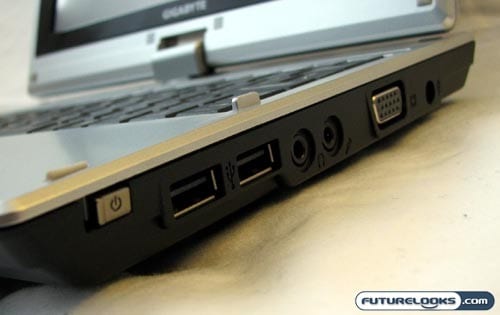What’s Included in the Box?

Inside the white box, you’ll discover the usual smattering of included accessories. You have the standard battery, the power adapter and cable, supporting documentation, and a provided soft sleeve with a Velcro enclosure for ease of portability. You may not want to use this sleeve on its own, but it provides some added protection for when you toss the netbook in your backpack. There is also a sheet that fits between the screen and keyboard when not in use.
Overall Design, Connectivity, and Ports

By and large, the GIGABYTE M912 is pretty conventional with its overall approach to design. If you’ve ever used a convertible tablet PC in the past, you should feel reasonably at home with this device, although it is a fair bit smaller. It is a netbook after all.
I think it’s nice how the top plate of the netbook comes with a bit of a design to it, giving you a little splash of style to an otherwise conventional-looking portable computer. The version I received had a black geometric design, though there is also a “Cafe Book” variant with a brown color scheme. The screen is held in place with a small pivoting joint near the center.
The footprint for the M912 is similar to other 8.9-inch netbooks, but it does appear to be a little bit thicker than some of its direct competitors. I would have preferred a thinner profile. Also, I found the overall build quality to be somewhat sub-par, as the choice of plastics seems to be on the cheaper side of things. You may also notice a little bit of flex and “creak” when manipulating this netbook; it doesn’t feel like it’s going to fall apart, but it doesn’t feel as solid as the ASUS Eee PC 1000HA, for instance.

Taking a quick spin around the GIGABYTE netbook, you’ll find no ports at the back. On the left side, you get the Kensington lock port, Ethernet port, exhaust vent, USB port, SD card slot, and ExpressCard slot. The front edge is home to the stereo speakers. Along the right side are the power switch, two USB ports, headphone and microphone jack, VGA port, and power jack.
It’s interesting to find the audio jacks on the right, since most laptops I’ve used have them on the left. This may cause a little bit of tangling for right-handed users, particularly if they are using an external mouse. Also, most headphones have their cord oriented to the left so it can possibly cause a bit of a crossover tangle. GIGABYTE should definitely consider moving those jacks to the left.
